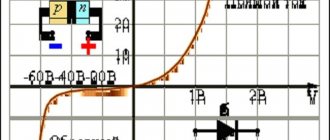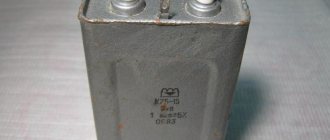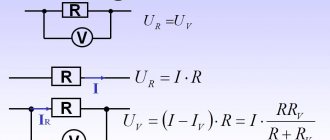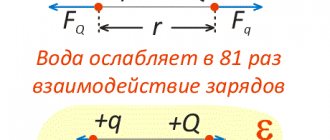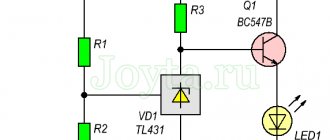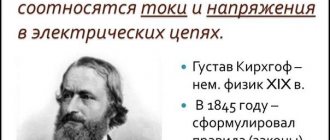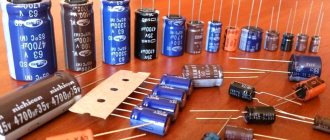Rectifier devices
Electromechanical devices with converters
High sensitivity, accuracy and low energy consumption distinguish magnetoelectric devices from other electromechanical devices. In view of this, they strive to use magnetoelectric instruments for measurements on alternating current. This problem is solved by converting alternating current into direct current and then measuring it using a magnetoelectric measuring mechanism.
Rectifier and thermoelectric converters, as well as converters based on electronic elements (electronic tubes, transistors, integrated circuits, etc.) are used as AC-to-DC converters. In accordance with this, rectifier, thermoelectric and electronic devices are distinguished. Electronic devices will be discussed in section 4.5.
Rectifier devices are a connection of a rectifier converter and a magnetoelectric measuring mechanism with a reading device.
In rectifier devices, one- and two-half-wave diode rectification circuits are used. When using a half-wave rectification circuit (Fig. 4.13, a)
Only one half-wave of alternating current passes through the measuring mechanism, and the reverse one is passed through diode
D2
and resistor
R.
A circuit of diode
D2
and resistor
R = RH
is used to equalize both half-waves of current in the common circuit, as well as to protect against breakdown of diode
D1
during reverse half voltage wave.
Fig.4.13. Half-wave (a) and full-wave rectification circuits
When using a full-wave rectification circuit, the rectified current passes through the measuring mechanism in both halves of the cycle and, therefore, the sensitivity of these circuits is higher than half-wave. In Fig. 4, b
shows the most common full-wave rectification circuit - bridge.
The rectifying properties of diodes are characterized by the rectification coefficient
(4.22)
where Ipr and I0bR are currents flowing through the diode in the forward and reverse directions; Rnp
and
Robr
are the forward and reverse resistance of the diode, respectively. The kB value depends on the voltage applied to the diode, the frequency of the current flow and the ambient temperature.
If alternating current is measured, then the instantaneous torque of the measuring mechanism when a pulsating rectified current flows through its coil
When using a rectifying device in an alternating current circuit of industrial or higher frequency, the deviation of the moving part of the measuring mechanism during half-wave rectification is determined by the average torque
(4.23)
and with full-wave rectification
(4.24)
where T
- period;
Iav
is the average measured current.
Angle of rotation of the moving part of the measuring mechanism with one- and two-half-wave rectification, respectively
(4.25)
From the obtained expressions it is clear that for rectifier devices, the deviation of the moving part is proportional to the average measured current.
When making measurements in AC circuits, you usually need to know the effective current (voltage). Considering that the effective current is associated with the equality Icр = I/kф,
where
kf
is the current waveform coefficient,
(4.26)
Thus, the rectifier device can be calibrated in effective current (voltage) values only for a given curve shape (for a sinusoid kfs = 1.11). If the shape of the measured current (voltage) curve is different from the specified one, an error appears in the instrument readings.
If the form factor kf
is known, then the effective current of a non-sinusoidal shape, measured by a device calibrated according to the sinusoidal current, can be determined by the formula:
(4.27)
The dependence of the diode rectification coefficient on temperature, applied voltage and frequency of the flowing current, as well as the influence of the shape of the measured current curve, leads to significant errors in rectifier ammeters and voltmeters. Errors are usually reduced by including additional correction elements in the instrument circuit.
The combination of a magnetoelectric measuring mechanism, a rectifying circuit, a shunt, or an additional resistor forms a rectifying ammeter or voltmeter.
In most cases, rectifying devices are multi-range and combined. With these devices, by switching the elements of the device using switches, you can measure both direct and alternating currents and voltages, as well as measure resistance using an ohmmeter circuit. The upper measurement limit for rectifier devices produced by the domestic industry is: current - from 3 mA to 10 A, voltage - from 75 mV to 600 V (the limit of 75 mV is only for constant voltage), resistance - from 0.5 kOhm to 5 MOhm
Due to the nonlinearity of the current-voltage characteristics of diodes at low values of alternating currents (voltages), the scale in the initial part (0-15%) is uneven.
Rectifier devices without frequency compensation can be used to measure currents and voltages up to frequencies of 5000 - 10,000 Hz; in devices with frequency compensation, the operating frequency range is expanded to 50 kHz. The accuracy of rectifying devices is relatively low - accuracy class is usually 1.5; 2.5.
High frequency rectifier modules
The foundation of the EPU, which determines both its static and dynamic characteristics, are rectifiers. Based on their operating principle, they are divided into the following types:
- low-frequency rectifiers, which include diode-thyristor and thyristor rectifiers, operating at the industrial network frequency;
- high-frequency rectifiers, also called rectifiers with transformerless input and high-frequency conversion.
Today, high-frequency rectifiers are used for modern power supply installations, therefore, we will consider them in more detail.
Figure 1.2 shows block diagrams of rectifiers with a transformerless input for station communication equipment. The presented block diagram (a) contains:
— input noise filter In. RPF (radio noise filter);
— network rectifier SV;
— input smoothing filter SF;
— adjustable voltage converter PN;
— output noise filter Out. PPF;
— control circuit Сх.У with an adjustable voltage converter;
- PA power amplifier.
Block diagram (b) differs from the one already considered in that instead of the input smoothing filter SF, a power factor corrector KKM with its own control circuit Cx.U KKM is installed at the output of the network rectifier.
Rice. 1.2. Block diagrams of VBB without power factor corrector (a) and with power factor corrector (b)
A rectifier is a static device that converts alternating current electrical energy into direct current electrical energy. The rectifier device is one of the main elements of any uninterruptible power supply system for telecommunications equipment and information networks.
Rectifiers with a power of less than 10 kW are often single-phase, while those with a power of more than 10 kW are three-phase. In the EPU structure, single-phase rectifiers can be connected to different phases of the power supply network, which makes it possible to increase the stability of the EPU operation in the event of an unreliable power supply and the possible loss of one phase.
Based on conversion frequency, rectifiers are divided into three groups:
— 30-50 kHz—one of the first rectifiers, which appeared about 25 years ago, operated at these frequencies. The operating principle is pulse width modulation (PWM). Their advantage is high maintainability, the disadvantage is relatively low reliability;
- 60-120 kHz. The operating principle is PWM. These conversion frequencies are used in most modern single-phase rectifiers;
- 300-500 kHz. The operating principle is phase resonance correction.
At the input of all rectifiers there is a power factor corrector, which allows not to introduce distortions into the supply network.
It should be noted that at high frequencies the design of rectifiers changes. For example, for the first rectifiers, a prototyping stage was carried out, but at frequencies above 50 kHz, the relative arrangement of the elements is quite strongly influenced, and parasitic capacitances appear. Therefore, computer simulation is used in the design of these rectifiers.
Computer modeling is an indispensable stage in the design of modern rectifiers, which makes it possible to increase their reliability (MTBF - from 5∙105 to 106 hours). The efficiency of modern rectifiers reaches 0.97, which is close to the theoretical limit. Low losses are ensured by the use of single-ended converter circuits and the replacement of rectifier diodes with field-effect transistors with extremely low pass resistances.
A significant characteristic of rectifiers is their ability to remain operational even with significant deviations in the input mains voltage. For these cases, you can find single-phase rectifiers that remain operational in the input voltage range from 85 to 300 V.
It should be noted that when the input voltage decreases, the current consumed from the external network increases, and this in turn requires changing the parameters of the protection devices (fuses or circuit breakers) at the rectifier input, which can reduce their operating efficiency. To avoid this, equipment manufacturers limit the minimum permissible voltage at the rectifier input (at which all its parameters are maintained) to approximately 170 V. With a further decrease in the input voltage, the output power of the rectifier is proportionally reduced.
EPU controller
The quality, reliability and performance characteristics of modern power supply installations for telecommunication systems are largely determined by the capabilities of the information technologies used.
Therefore, one of the most important elements of modern electronic control units is the controller. In addition to monitoring the current parameters of the ECU equipment, storing in memory all changes in operating modes and equipment failures, the controller is able to control the sequential shutdown of secondary loads in the event of loss of external power supply and when operating on battery power, ensuring longer operation of priority consumers. There are controllers that allow you to control not only the EPU itself, but also monitor the entire building - from electrical equipment to the security system.
The use of digital control signals in ECU circuits instead of analog ones provides a significant increase in reliability due to an increase in the capabilities of fault diagnosis (the CAN - Controller Area Network standard is mainly used). During diagnostics, not only a signal is transmitted remotely that, for example, the rectifier is already faulty or the voltage on the battery is low and it turns off, but in addition information about a violation of the operating mode of the rectifier elements (the rectifier itself is still working) or a change in the voltage distribution on the elements batteries, that is, about the causes of malfunctions.
Batteries
In modern uninterruptible power supply systems, rechargeable batteries (AB) are almost universally used to reserve DC electrical energy during short-term outages of external power supply.
At its core, a battery is a chemical source of multiple current. According to the International Electrotechnical Dictionary IEC 50 (486)-1991 “Accumulators and storage batteries”, a battery (cell) is a collection of electrodes and electrolyte that forms the basis of the battery device. A battery is two or more batteries (cells) connected to each other and used as a source of electrical energy.
During the battery discharge process, the active substances of the anode, cathode and electrolyte are converted into discharge products, and their chemical energy is converted into electrical energy. During charging, the supplied electrical energy is consumed to regenerate the discharge products. The battery is charged by passing an electric current through it, causing chemical reactions, as a result of which one of the battery electrodes acquires a positive charge and the other a negative charge.
The main advantage of batteries over other backup power sources is that, when discharged, the battery is able to stabilize the voltage. The discharge curve of a battery has a flat section, unlike, for example, a capacitor, whose discharge curve is exponential.
Today, lead-acid batteries are most widely used in power supply systems. Other types of batteries are also used, such as nickel-iron or nickel-metal hydride. In addition, lithium batteries have been increasingly used recently. Each of the listed battery types has its own advantages and disadvantages.
Let us present the main electrical and operational parameters of the battery, which will also be useful in further calculations.
The following main parameters can be distinguished:
· Nominal capacity Cnom
-
this is the amount of electricity that can be obtained from a 100% charged battery or battery at rated discharge current values and ambient temperature, as well as a given final discharge voltage at the battery terminals.
The value is expressed in ampere hours; usually indicated on the battery or on its packaging; · Rated voltage Unom – the average conditional value of the voltage at the battery terminals during its discharge in the nominal mode specified in the technical specifications; expressed in Volts. The rated voltage of the battery is determined by the product of the number of elements connected in series by the rated voltage of one element;
· Rated discharge current Irn – as a rule, indicated in fractions of the rated capacity;
· The internal resistance of the battery is a parameter determined by calculation based on the steady-state voltage values when the battery is discharged by currents of sufficiently high magnitude. Given by the manufacturer in the technical documentation, usually in milliohms;
· Battery service life (in case of operation in continuous charging mode), or the permissible number of charge-discharge cycles.
Also, when choosing batteries, an important role is played by its weight, size and design parameters, the possibility of installing it in hardware racks and on shelving, and, of course, cost.
